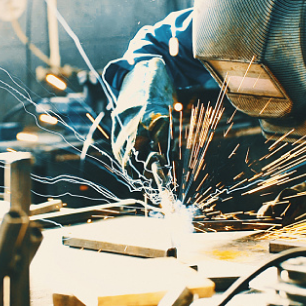Jump to:
New Undercut Tolerances and Treatments in the 2025 D1.5, Bridge Welding Code
The 2025 edition of AASHTO/AWS D1.5M/D1.5, Bridge Welding Code (https://www.aws.org/standards-and-publications/codes-and-standards/d15m/), features new undercut tolerances and treatments for addressing nonconforming undercut. The code also clarifies how to apply the undercut tolerances. This article describes the code changes and compares the provisions of the updated code with those of the 2020 edition.
New Tolerances
Previously, D1.5M/D1.5:2020 Clause 8.26.1.5 listed two undercut tolerances: 0.01 in. for undercut transverse to tensile stress and 1/32 in. deep for all other cases. In the 2025 edition, this subclause has been expanded to include three tolerances:
0.01 in. — This tolerance remains for welds transverse to primary tensile stress, including groove welds in the tension flanges and tension zones of webs and fillet welds transverse to tension. Further, the 2025 code clarifies that for fillet welds, this tight undercut tolerance only applies to the fillet weld toe that is directly on the tension component (D1.5M/D1.5:2025 Clause 8.26.1.5 [1]).
1/8 in. — This new tolerance applies to the corners of stiffeners and connection plates (D1.5M/D1.5:2025 Clause 8.26.1.5 [2]).
1/16 in. — This new tolerance value applies everywhere else that the 0.01- and 1/8-in. tolerances do not apply. This new value generally replaces the previous 1/32-in. tolerance. Note that on fillet welds transverse to tension, this new tolerance applies to the weld toe at the nontensile components, such as at the toe touching stiffeners and connection plates. A new figure in the commentary (D1.5M/D1.5:2025 Figure C-8.1) graphically expresses the distinction in allowance by fillet weld toe. The difference in allowance by toe is not new, but the new code commentary figure clarifies that assessment by toe (i.e., regarding the individual base metal components) is the proper way to apply undercut tolerances.
Regarding the new 1/8-in. tolerance, undercut at the corners of stiffeners and connection plates is not common, as welds on these areas are usually stopped short and not wrapped, primarily to avoid such undercut. However, it may be desirable to wrap the welds to preclude rust from bleeding onto the coating. Research at the University of Texas at Austin demonstrated that wrapping welds and getting up to a 1/8-in.-deep undercut on stiffener and connection plate corners, such as that shown in the lead photo, does not compromise fatigue performance (Ref. 1) (https://fsel.engr.utexas.edu/pdfs/0_4178_1.pdf). Hence, the code has adopted this 1/8-in. allowance to facilitate wrapping when the engineer desires it.
New Treatment
Undercut that does not meet code requirements must be addressed because undercutting results in a sharp notch in the base metal just beyond the weld toe, and sharp discontinuities are not preferable for fatigue performance (hence the tighter undercut restrictions for weld toes transverse to tension). There are no practical means to measure the undercut notch’s sharpness; thus, the code uses depth as an overall measure of undercut severity. Previously, the code only allowed undercut to be repaired by welding (D1.5M/D1.5:2020 Subclause 5.7.2.2), although the 2020 commentary states, “Repair by light grinding is generally superior to cosmetic weld repairs.” The 2025 code edition introduces a preference for addressing undercut by grinding to blend it out rather than adding additional weld metal, provided the undercut is not too deep. The revised language in Subclause 5.7.2.5 (1) specifies that undercut less than or equal to the allowable depths shall be repaired by grinding. The code further states, “Grinding shall result in a smooth surface.” New code commentary Figures C-5.8 and C-5.9 (Figs. 1 and 2, respectively) illustrate the before and after of such treatment.
Committee members discussed how to best remove the sharp point in undercut. One approach that was considered involved using a rounded burr grinding bit (Fig. 3) to produce the desired contour. However, shop personnel felt that the small, hard bits would dig too easily into the base metal, potentially creating deep excavations (shown in Fig. 3). Instead, they suggested using a 4-in. grinding wheel. As shown in Fig. 4, shop personnel ran tests on mock-ups and found this approach very effective. Consistent with its typical approach in developing code language, the committee refrained from prescribing tools in the specification, leaving this to the fabricator. However, in the commentary, the code continues to mention “repair by light grinding.”
Grinding to remove sharpness may make the remaining depression deeper than the original undercut, so the committee adopted the following depth limits associated with undercut blending:
Grinding shall not reduce the net cross section to less than 98% of the nominal area. (D1.5M/D1.5:2025 Subclause 5.7.2.5 [1]). The committee has adopted the same 98% rule in several other locations in the code.
In weld toes transverse to tension, further to the 98% rule, there are specific depth limits, and these are associated with the thickness of the base metal. The limits are shown in Fig. 5. They vary from 1/32 in. for plates less than or equal to 1 in. thick up to 1/8 in. for plates over 2 in. thick (D1.5M/D1.5:2025 Subclause 5.7.2.5[1][a]). For example, in a 1-in.-thick plate, undercut greater than 0.01 in. would be repaired by grinding, and after grinding, the resulting depression must be smooth and not be greater than 1/32 in. deep. If the resulting depression is greater than 1/32 in., the undercut must be repaired by welding. If the initial undercut is greater than 1/32 in. deep, there is no point in grinding it, and it would be repaired by welding at the onset.
In weld toes parallel to tension or in compression, further to the 98% rule, undercut may not be deeper than 1/8 in. after grinding to smoothness, regardless of thickness (D1.5M/D1.5:2025 Subclause 5.7.2.5 [1][b]).
In cases where undercut or the resulting condition after grinding exceeds allowable depths, the condition must be repaired by welding (D1.5M/D1.5:2025 Subclause 5.7.2.5 [2]).
Improving Bridge Quality
As D1.5 approaches its fourth decade in service, we celebrate the publication of the code’s new edition. Hundreds of thousands of bridges have been fabricated to the code and are providing excellent service. The new undercut provisions represent one more code improvement aimed at elevating steel bridge quality, delivering greater value and exceptional long-term performance.
Reference
1. Spadea, J. R., and Frank, K. H. 2002. Fatigue Strength of Fillet-Welded Transverse Stiffeners with Undercuts. Austin, Tex.: Center for Transportation Research, the University of Texas at Austin. (https://fsel.engr.utexas.edu/pdfs/0_4178_1.pdf)
This article was written by Ronnie Medlock (vice president of technical services at High Steel Structures LLC) for the American Welding Society.


